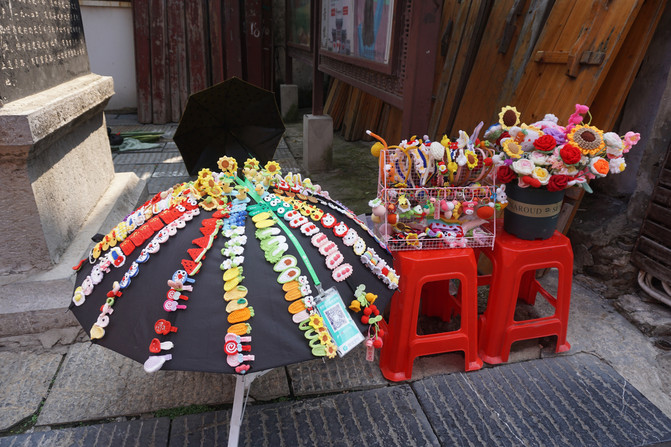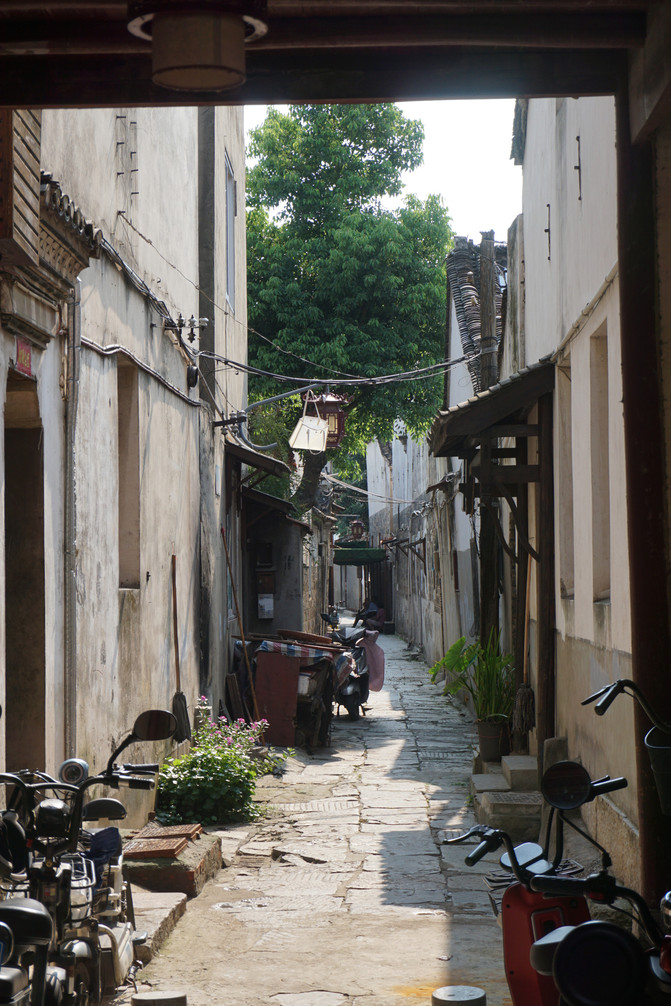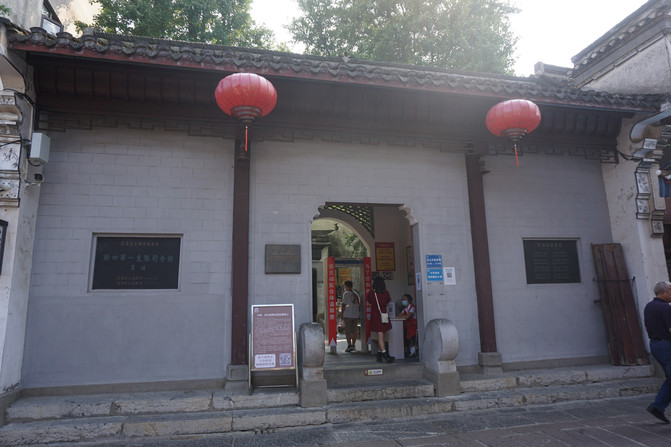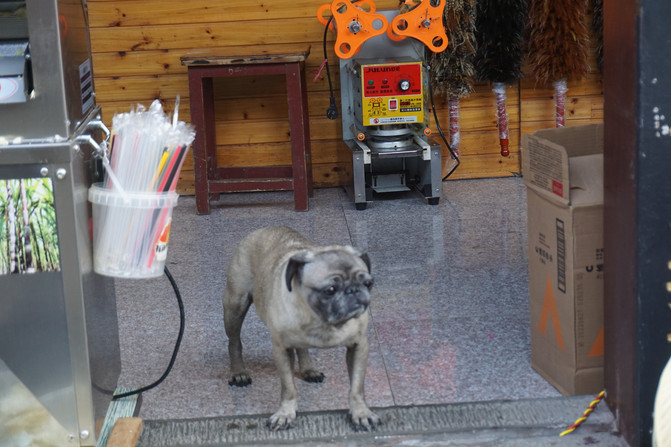Nanjing people look at Nanjing--stroll around Gaochun Old Street
Crossing Chunxing Road is the big square in front of the old street

The main gate of the old street has cornices and corners, and horse-head walls in the Hui-style style.

The entrance building leads to a long main street. It is said to be an old street, but in fact it is a large area with patches of Ming and Qing architectural complexes. The middle roads and alleys in the block are vertical and horizontal. The main street is more than 800 meters long and four to five meters wide, extending east-west in a "one" shape. The buildings on both sides are brick-and-wood structures, with one-surface shop buildings and two floors.

The old street is very lively, and the superb craftsmanship of traditional folk craftsmen attracts many tourists.

Selling hairpins has sold new ideas and new styles.

The gate building is not located in the middle of the main street, but on the east side. The distance to the east is short and there are few tourists.

The distance to the west is long and there are many stores, so there are many tourists. We came to the old street to play just to join in the fun. We first chose to go west to join in the fun.

In addition to the main street, the old street is dotted with streets and alleys. The indigenous people of Lao Street still live here, which has a very market-like atmosphere.

It can be seen from the side of the building that there are most three shops in the old street, which are several in depth. The houses have carved windows, horse-head fire walls, and small butterfly tiles, with typical Jiangnan charm, which is blended into the Hui style.

Although the streets and alleys in the block are crisscross and crisscross, there is no sense of narrowness and urgency. There is an open small square here, and on one side of the square there is an archway that is "famous all over the south of the Yangtze River".

The old street is rich in content, not only with various shops, but also some attractions. Some of the attractions are on the main street, and some are on the fork roads next to the main street. There are arrow signs on the streets. If you are interested, you can visit one by one. We were traveling with a group and the time was limited. We could only walk along the main street and pass by to have a look. In the middle of the old street, there is a three-room Wu family ancestral temple built during the Qianlong period of the Qing Dynasty. In 1938, Chen Yi led the First Detachment of the New Fourth Army eastward to resist Japan and stationed the headquarters here. Therefore, it is now open to the public as the former site of the headquarters of the First Detachment of the New Fourth Army.

There is a small sunny courtyard right into the entrance building. There are three entrances to the ancestral hall, and there is a courtyard and patio between each entrance.

Brick and wood structure, Anhui style. The mottled moss on the white wall is a mark of time. The trees in the courtyard are tall and old.

The ancestral hall faces the Guanxi River and its back faces the old street. There are three entrances, so we enter from the main street end is actually the third entrance-the Sacrifice Hall. It is now used as an exhibition hall.

Through pictures, display boards, and text, it is introduced during the Anti-Japanese War. When Commander Chen Yi personally led the First Detachment of the New Fourth Army to pass Gaochun in June 1938, he established the headquarters of the First Detachment of the New Fourth Army here.

During his stay in Gaochun, Commander Chen did a lot of work on the anti-Japanese united front and left behind the magnificent poem "Arriving in Gaochun at the Beginning of the Eastern Expedition".

Walking out of the exhibition hall, there is a courtyard with two tall osmanthus trees in the courtyard.

This is the first time I have seen such a tall osmanthus tree, and I tried my best to photograph its entire body, in vain.

On this side of the patio are two entrances-a meeting hall, front and rear corridors, an open hall style, a small tiled roof, and a horse-head wall.

The space of the meeting hall is tall, with nanmu pillars and cypress beams, solemn and heavy.

Moving forward again is a step into the theater. The wood carvings of dragons, phoenixes, lions, and folk stories on the theater are lifelike, showing the style of a large family.

There is a pool in the side yard

There is a pair of magnificent stone lions in front of the door. At first glance, it is obvious that it is no ordinary place. It turns out to be Guanwang Temple. The Guanwang Temple was built in the second year of Hongzhi of the Ming Dynasty (AD 1489) and housed Zhang Fei, Li Jing, Qi Jiguang, etc., loyal and martial soldiers of the past dynasties.

Old Street is very cultural. This is a building built in the Qing Dynasty and is now an art museum.

Gaochun Baishi Painting and Calligraphy Institute

An old street book shop with a straightforward name

The door face, door beam, and door plaque are all antique.

When I walked in, I found that it was not just a bookshop, but a very stylish resting place for literary and artistic petty bourgeoisie. The narrow and narrow space that has almost been extended inward. Coffee, desserts and teas are sold in the bookstore, and there is always one that will attract you to sit here.

A high platform is made on the left side, and there are several seats on the high platform for people to rest. The walls are full of tea-related objects.

A slender display cabinet on the right displays old objects of Gao Chun

The walls of the store are decorated with exquisite stone carvings

There is also a second-floor space in the study room. You can go up to the second floor at a corner of this place.

Tourists left their hearts here, either to one person or just to themselves.

Indomitable bookshelves also play a role in dividing space. A few more steps forward and go through this door

When you come outside, you will find yourself in a green courtyard. You will sit here and bask in the sun and taste the coffee from the store. The desserts are really leisurely and comfortable.

The old street heading west is very lively, with many shops and tourists. There are also many restaurants in all shops. There are restaurants, snacks, and various delicious specialties.

Autumn is the season when crabs are on the market, and the old street located by the lake of Gucheng Lake is full of crabs. In addition to serving crab meals, each restaurant also sells crabs directly.

In addition to crabs, there are lotus seedlings in this season.

Seeing that many shops display pomegranate in this way, is pomegranate also a specialty of Gaochun? The pomegranate here is big, full of grains, and bright in color, which is really tempting. Give me a cup of pomegranate juice, squeeze it purely, without adding a drop of water, and I was amazed at the first bite. Wow, this is the first time I have tasted this feeling, and it is sweet to the bottom of my heart.

From the main street, there is a north-south food street. I have no special interest in eating, and I just look around at the alley entrance.

This store sells Gaochun specialties

Because of the excitement, I unknowingly walked to the west of the main street. There is a tall archway on the west side as a sign, distinguishing the old street from the modern city outside the street.

Seeing that there was still some time before the departure and return journey, we went back along the main street and continued to stroll towards the east end of the main street. After passing the gate building, the main street in the east suddenly became much quieter. Because there are few people, you can take a closer look at this somewhat historical street. There are now 314 shops in the old street, most of which were built in the Ming and Qing Dynasties. The shops are all building-style double-layer brick-and-wood structures, with two upper and lower floors, wooden platoon door panels, and most of them have front shops and back houses.

The streets are all paved with bluestone and rouge, and the pink rouge in the middle is laid horizontally. It is uneven, antique and has a unique charm. Both sides of the rouge stone are paved lengthwise with bluish-gray limestone strips. The whole street has bright complexion, neat and beautiful. After eight hundred years of wind and rain, people and cars, it is still strong and durable. There are many shops on both sides of the street, all of which are old buildings with white walls and black tiles.

The little cute guy guarding the store


It took an hour to measure it from west to east on the main street of the old street. If you have time to walk through the small streets and alleys of the old street, it will be more interesting to find the atmosphere of the market that is not prepared for tourists.

This may be a new beginning for me. For the first time, I started slow travel with marketing purposes with the "senior group". Without thinking too much about it, just enjoy the journey right now.
Previous Article:Nanjing 丨 is as free as a wild crane in idle clouds
Next Article:Nanjing Ming City Wall--Walking on the City Wall on the 16th of the first month
